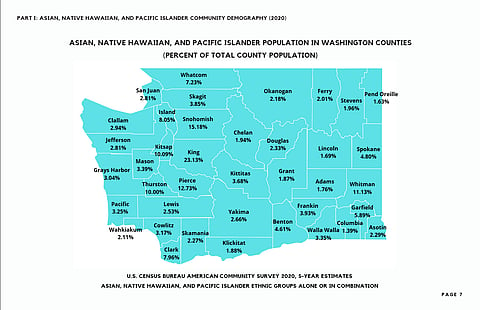Washington State Commission on Asian Pacific American Affairs Releases 2020 Community Demography Report
by Ronnie Estoque
On Jan. 6, the Washington State Commission on Asian Pacific American Affairs (CAPAA) announced the release of its 2020 Community Demography report. The report provides demographic information of Asian, Native Hawaiian, and Pacific Islander (ANHPI) racial and ethnic groups based upon the 2020 census data and was disaggregated using microdata from the U.S. Census Bureau's 2020 American Community Survey (ACS).
According to a CAPAA press release statement from Jan. 6, "The report finds that ANHPI's (alone or in combination with another racial group) together represent the state's second-largest minority group, with 12.64% of the state's population identifying as one of these groups. Hispanic/Latino's still represent the largest minority group, with 12.93% of the state's population. ANHPI's also represent the fastest-growing population with a growth rate of 40.76%, compared to that of the Hispanic/Latino population with a growth rate of 28.54% from 2010 to 2020."
CAPAA partnered with KAYA strategik LLC, a Seattle-based, women- and immigrant-owned consulting firm, to support the creation of the report. Cherry Cayabyab serves as the owner and principal for KAYA and is a co-founder of the Washington Census Alliance (now the Washington Community Alliance), a statewide coalition of over 70 organizations led by and for working-class Communities of Color. She also helped develop the King County Census 2010 "Make Our Community Count" coalition and has over 20 years of experience in the census field. Devon Abdallah and Jazmine Christen of KAYA also helped author the report alongside Cayabyab.
"The KAYA strategik team partnered with CAPAA and authored the 2020 Community Demographic report to have a deep and updated understanding of the growth and population status of Native Hawaiians, Pacific Islanders, and Asian communities in Washington State based on the most recent 2020 census and five-year American Community Survey," Cayabyab said. "The results in this report reflect years of our civic participation in the census 2020 to make sure the demographic picture of our historically undercounted communities are as accurately reflected as possible in our data — which informs equitable public policy and advocacy."
Toshiko Hasegawa serves as the CAPAA's executive director and acknowledged that one of the tremendous challenges of producing the report was the Trump administration, as it delayed the release of the latest census data, which ultimately delayed the timeline of this project. She also emphasized the importance of releasing the CAPAA report ahead of the legislative session.
"The goal of this report, at a top tier level, is for it to be a useful resource for state agency partners, for the Department of Commerce and all the other state agencies, for the governor's office in the state legislature, to be able to refer to, [to] know about the NHPI communities. It is also a public document with the hopes that this will be useful for communities."
Hasegawa also explained how the ethnic categories in the census data are "not very exhaustive or inclusive," and that microdata from the ACS aided in the creation of the report as it provided more inclusive ethnic category data for the report.
"Our communities are not monolithic, and that's the challenge with data. The challenge and the goal is to let the data tell as inclusive a story of who we are as possible. Although we're very proud of the level of disaggregation we aim to achieve, it is still not exhaustive or inclusive of all groups, all cultures, all identities, all issues," Hasegawa added. "It's a starting point. Data is flawed, but it is also a tremendously powerful tool."
Hasegawa leaned on community organizations, such as the Pacific Islander Community Association of WA, to receive feedback on how to ensure their data collection process was also complementary to the ANHPI community's needs. CAPAA also worked closely with the Asian Pacific Islanders Coalition of Washington, which encapsulates various nonprofit organizations that work directly with communities represented in the report. Community organizations looking for investments at the state level can utilize data to justify the importance of increased financial support to meet the needs of a growing ANHPI population in Washington.
"The best way for us to be able to understand the evolving needs of this tremendously large and diverse community is by continuously engaging with them directly," Hasegawa said. "This tool should be one of many that politicians and decision-makers and folks in public service and advocates should lean on."
Editors' Note: A previous version of this article incorrectly described the Washington Community Alliance as a state agency. This article was updated on 02/27/2023 with a correct description.
Ronnie Estoque is a South Seattle-based freelance photographer and videographer. You can keep up with his work by checking out his website.
Featured Image: U.S. Census Bureau American Community Survey 2020, with five-year estimates, show Asian, Native Hawaiian, and Pacific Islander ethnic groups as percentage of total county population in Washington States. (Source: 2020 Community Demography Report from Washington State Commission on Asian Pacific American Affairs).
Before you move on to the next story …
The South Seattle Emerald™ is brought to you by Rainmakers. Rainmakers give recurring gifts at any amount. With around 1,000 Rainmakers, the Emerald™ is truly community-driven local media. Help us keep BIPOC-led media free and accessible.
If just half of our readers signed up to give $6 a month, we wouldn't have to fundraise for the rest of the year. Small amounts make a difference.
We cannot do this work without you. Become a Rainmaker today!
Help keep BIPOC-led, community-powered journalism free — become a Rainmaker today.


